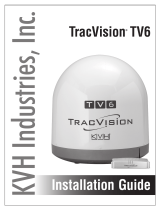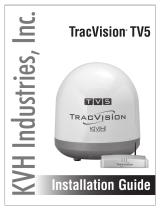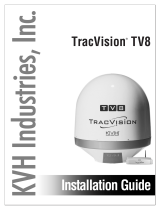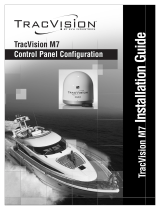Page is loading ...

Tri-Americas™ LNB Installation Guide
1
KVH, TracVision, Tri-Americas, and the unique light-colored dome with dark contrasting baseplate are trademarks of
KVH Industries, Inc. All other trademarks are property of their respective companies. The information in this document is subject to
change without notice. No company shall be liable for errors contained herein. © 2009 KVH Industries, Inc., All rights reserved.
54-0622-03 Rev. A
TracVision M9 Configuration
These instructions explain how to install the Tri-Americas LNB in your
TracVision® system. With the Tri-Americas LNB, you no longer need to
climb up to the antenna and change the LNB when you travel between
North America, the Caribbean, Central America, and South America.
Depending on the LNB currently installed in the antenna, you might
need to bypass the inverter PCB. Follow the guidelines below.
Steps Required
Technical Support
Phone: +1 401 847-3327
E-mail: [email protected]
(Mon.-Fri., 9 am-6 pm ET, +5 GMT)
(Sat., 9 am-2 pm ET, +5 GMT)
Currently Installed LNB: Perform Steps:
• Conventional Circular
•Galaxy
1. Initial Steps (page 3)
2. Bypass the Inverter PCB (page 4)
3. Install the Tri-Americas LNB (page 7)
4. Install the Tone Generators (page 9)
• Compact Circular
•Linear Dual-output
• Linear Quad-output
1. Initial Steps (page 3)
2. Install the Tri-Americas LNB (page 7)
3. Install the Tone Generators (page 9)
Dual-output
Linear LNB
Quad-output
Linear LNB
Conventional
Circular LNB
Galaxy
LNB
Compact
Circular LNB

3
Follow these steps to begin the LNB installation.
a. Gather all of the tools listed below. You will
need these tools to complete the process.
• #2 Phillips screwdriver
• 5/64" allen hex key
•Wire cutters
• 7/16" open-end wrench
b. Disconnect power from all system
components, including the receiver(s).
c. Using a #2 Phillips screwdriver, remove the
eight #10-32 screws securing the radome to
the antenna’s baseplate (see Figure 1).
Remove the radome and set it aside in a safe
place.
CAUTION
For your own safety, disconnect power from
all system components before you start
working on the antenna.
#10-32 Screw (x8)
Baseplate
Radome
Figure 1: Removing the Radome
Avoid causing sharp bends in cables when
securing or routing cables. Sharp bends or
kinks can degrade antenna performance.
IMPORTANT!
Trim the excess portion of any tie-wraps you
install and collect all tie-wrap trimmings to
avoid damage when the antenna rotates.
IMPORTANT!
Initial Steps

4
If your TracVision system is currently equipped
with a Galaxy or conventional circular LNB, you
must first bypass the inverter PCB (see Figure 2).
The following instructions explain how to bypass
the inverter PCB.
a. Using a 7/16" open-end wrench, disconnect
and remove the RF cable connecting the
inverter PCB to the RF PCB (see Figure 3).
b. Disconnect the RF cable from the inverter
PCB’s “RF1 TO LNB” connector and connect
it to the RF PCB’s “TO LNB” connector (see
Figure 4).
LNB
Inverter PCB
RF PCB
Figure 2: Location of Inverter PCB
RF2 FROM IRD
RF2 TO LNB
RF1 TO LNB
RF1 FROM PCB
RF Cable
Figure 3: Cable Connecting the Inverter PCB to the RF PCB
RF2 FROM IRD
RF2 TO LNB
RF1 TO LNB
RF1 FROM PCB
RF Cable
Figure 4: Moving the RF1 Cable
Bypassing the Inverter PCB

5
c. Apply an “RF2” label to the RF cable
connected to the inverter PCB’s “RF2 FROM
IRD” connector (see Figure 5).
d. Using wire cutters, cut and remove the tie-
wraps at the three locations shown in
Figure 6.
RF2 Label
RF2 FROM IRD
RF2 TO LNB
RF1 TO LNB
RF1 FROM PCB
Figure 5: “RF2 FROM IRD” Connector on Inverter PCB
1
2
3
Figure 6: Cable Bundle Tie-wrap Locations
Continued Bypassing the Inverter PCB

6
e. Cut and remove the tie-wrap securing the RF
cables to the back of the PCB module (see
Figure 7).
f. Disconnect and remove the cable connecting
the inverter PCB to the LNB’s RF2 connector
(see Figure 8).
g. Disconnect the “RF2”-labeled cable from the
inverter PCB (see Figure 5 on page 5).
h. Temporarily connect the “RF2”-labeled cable
to the LNB’s RF2 connector (see Figure 9).
i. Apply an “RF1” label to the other RF cable
that is connected to the LNB (see Figure 9).
Tie-wrap
PCB Module
Figure 7: Tie-Wrap Securing RF Cables to the PCB Module
RF2 FROM IRD
RF2 TO LNB
RF1 TO LNB
RF1 FROM PCB
RF Cable
RF2RF1
Figure 8: Removing the RF2 Cable
RF1 RF2
Figure 9: RF Connectors on Old LNB (Example)
Continued Bypassing the Inverter PCB

7
Follow these steps to disconnect and remove the
old LNB and install the new Tri-Americas LNB in
its place.
a. Check the RF cables that are connected to the
current LNB. Make sure the cables are labeled
appropriately as shown in Figure 10. Label
the cables as necessary.
b. Disconnect the RF cables from the current
LNB.
c. Connect the RF1 and RF2 cables to their
corresponding connectors on the Tri-
Americas LNB (Figure 11).
d. Using a 5/64" allen hex key, loosen the two
#8-32 set screws securing the current LNB to
the choke feed (see Figure 12).
e. Remove the old LNB.
f. Insert the new Tri-Americas LNB fully into
the choke feed with the connectors aligned
upright.
g. Tighten the two set screws to secure the LNB
in place.
Conventional
Circular LNB
Galaxy
LNB
Compact
Circular LNB
RF1 RF2
RF1 RF2
RF1
RF2
Dual-output
Linear LNB
Quad-output
Linear LNB
RF1 RF2
RF4
RF3
RF1 RF2
Figure 10: RF Connectors on Old LNB
Figure 11: Tri-Americas LNB RF Connectors
RF2RF1
Figure 12: LNB Retaining Screws
Set Screw (x2)
Choke Feed
Installing the Tri-Americas LNB

8
h. Using 9 tie-wraps (supplied in the kit), secure
the RF cables to each other and to the LNB in
the locations shown in Figure 13. These tie-
wraps will prevent the cables from getting
snagged while the antenna is in motion.
i. Using a tie-wrap, secure the RF cables to the
back of the PCB module in location #1 shown
in Figure 14 (if it is not already in place).
j. If you are replacing a linear quad-output
LNB, apply rubber caps over the connectors
of the unused RF3 and RF4 cables to protect
their center conductors. Then, using 3
tie-wraps, secure the RF3 and RF4 cables to
the antenna frame at locations #2-4 shown in
Figure 14.
k. Reattach the radome (see Figure 1 on page 3).
Figure 13: Securing RF Cables to the LNB
1
2
5
3
4
6
7
8
9
PCB Module Frame
12
4
3
Figure 14: Securing RF Cables to the PCB Module and Frame
Continued Installing the Tri-Americas LNB

9
Two 22KHz tone generators are supplied in the
kitpack. Install these devices in-line with the
antenna’s RF cables as explained below. If a
multiswitch is installed, skip to page 10.
a. Disconnect the RF1 cable from the primary
receiver’s “Satellite In” connector.
b. Connect the RF1 cable to the 22KHz tone
generator’s “LNB” connector.
c. Connect a supplied RG-179 RF cable from the
22KHz tone generator’s “REC” connector to
the primary receiver’s “Satellite In”
connector.
d. If you have a second receiver installed, repeat
steps a-c to install the second 22KHz tone
generator between the secondary receiver
and the RF2 cable.
e. Set the 22KHz tone generator’s “22KHz OFF/
ON” switch to the proper position for the
satellite TV service you wish to receive:
OFF = DIRECTV, DISH Network, ExpressVu
ON = DIRECTV Latin America (Galaxy)
If you have two receivers installed, set the switch
on both 22KHz tone generators.
f. Reconnect power to the TracVision system
components.
g. Turn on the TracVision antenna and
configure it to track satellites that are
compatible with the Tri-Americas LNB.
These include DIRECTV, DISH Network
(EchoStar), ExpressVu, or Galaxy. Refer to the
TracVision M9 User’s Guide for details.
Antenna
Secondary Receiver - Optional
Primary Receiver
This receiver controls satellite selection
RF1RF2
(Optional)
RF1RF2
(Optional)
22KHz Tone Generator
Set switch “ON” for Galaxy
22KHz Tone Generator
Set switch “ON” for Galaxy
Grounding Block
(If Installed)
Satellite In
Satellite In
LNB
REC
LNB
REC
Figure 15: Tone Generator Wiring
Installing the Tone Generators
One or Two Receivers

10
If a multiswitch is installed, follow these steps to
install the supplied 22KHz tone generators.
a. Disconnect the RF1 cable from the
multiswitch’s “13V” connector.
b. Connect the RF1 cable to the 22KHz tone
generator’s “LNB” connector.
c. Connect a supplied RG-179 RF cable from the
22KHz tone generator’s “REC” connector to
the multiswitch’s “13V” connector.
d. Disconnect the RF2 cable from the
multiswitch’s “18V” connector.
e. Connect the RF2 cable to the second 22KHz
tone generator’s “LNB” connector.
f. Connect a supplied RG-179 RF cable from the
second 22KHz tone generator’s “REC”
connector to the multiswitch’s “18V”
connector.
g. Set the “22KHz OFF/ON” switch on both
22KHz tone generators to the proper position
for the satellite TV service you wish to
receive:
OFF = DIRECTV, DISH Network, ExpressVu
ON = DIRECTV Latin America (Galaxy)
h. Reconnect power to the TracVision system
components.
i. Turn on the TracVision antenna and
configure it to track satellites that are
compatible with the Tri-Americas LNB.
These include DIRECTV, DISH Network
(EchoStar), ExpressVu, or Galaxy. Refer to the
TracVision M9 User’s Guide for details.
22KHz Tone
Generators
Set switches
“ON” for Galaxy
Satellite In
Satellite In
Satellite In
Receiver #3
Receiver #2
Receiver #1
Receiver #4
Satellite In
RF2 RF1
RF2 RF1
AC Power
13V
SAT
Rx4
ANT
IN
Rx3
DC
20V
Rx2
Rx1
18V
SAT
Grounding Block
(If Installed)
LNB
REC
LNB
REC
Figure 16: Tone Generator Wiring, Multiswitch Configuration
Installing the Tone Generators
Three or More Receivers
/










